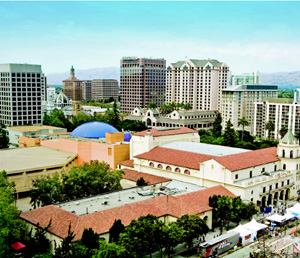At present, Class A San Jose multifamily properties are selling at a median price of $215,500 per unit and a median cap rate of 4.7 percent. The market among larger investors is so desirable that many REIT-worthy deals of around 100-plus units are rarely even brought to market. Instead, they are trading principal-to-principal in off-market deals. They also are being traded under fierce competition among investors who may have missed the last run-up in San Jose and are determined not to miss it this time around. One such deal, a 311-unit Archstone Community property in the South Bay town of Cupertino, recently sold for a premium without technically going to market. It hit a near-unheard-of price per unit of $282,958 and a cap rate of just 4.3 percent.
THE OPPORTUNITY Though larger properties are in high demand, there has been somewhat of an adjustment in the sub-100 unit market. This market, driven by mid- to small-size investors, is greatly affected by interest rates, and as interest rates have climbed, there has been a downward pressure on prices. Although this price pressure has had a positive impact on cap rates, many sellers are still reluctant to reset their prices, so these properties tend to stay on the market for longer periods of time or are pulled off altogether as sellers give up in frustration. This, coupled with a realization among buyers that they, too, might have missed the recent boom market, has caused the volume of transactions in the mid-size property category to level off.
If there is one thing the smaller investor might glean from large investor activity, it may be that the best move in San Jose lies in making money through long-term plays. In other words, buy a property, improve its operational efficiencies, and increase rents in an effort to grow cap rate and cash flow. On this front, the small investor, just like the institutional investor, could gain greatly from the changing demographic of San Jose renters and the recent influx of immigration, both of which have created demand for small apartment product and allowed properties of four to 20 units to hold their value.
Value-added opportunities from both large and small properties have generated a lot of interest as well. A lot of this activity is occurring among properties that are the result of the 1960s San Jose apartment boom, when smaller properties of four to 40 units were built en masse. With land in such short supply, many investors are turning to these units to refurbish or redevelop as multifamily product and not condominiums. Refurbished units in this class are selling at prices between $150,000 to $185,000 per unit and renting at rates that range from $1,400 to $1,800 per month, depending on size and location.
THE FUTURE As it enters yet another upswing, the San Jose multifamily market represents strong opportunity. Home ownership is expensive, rental demand is high and there is limited new construction competition to speak of. The employment sector is not only solid, but a source of new frontiers for exploration. One of the most significant of these may be San Jose’s ability to turn its collective intelligence, capital and resources toward solving one of the most pressing problems today—earth-friendly energy. The market is doing this with a combination of computer processing power and solar energy, or the combination of silicon and solar, to improve on and initiate technologies that create massive amounts of clean energy. In the process, the Silicon Valley may someday become Solar Valley and, combined with opportunities in software, biotechnology, medical devices, telecommunications, and other existing technology applications, could serve as a forerunner in rebuking the concept that technology is moving solely in the offshore direction.
These trends in the job sector are further supported by a continuing influx of venture capital. Of a nationwide pool of $5.7 billion in venture capital funds, the Silicon Valley captured approximately $2 billion, representing an 8.5 percent increase in local venture capital funding from 2005 to 2006. An estimated 37 percent of this goes to local companies, which in turn generate approximately 16,000 new jobs annually.
When it comes to the link between economic potential and the need to invest now in San Jose commercial real estate, the REITs see it, the developers see it and the large institutions see it. If more individual investors also leave the sidelines and begin to operate with an eye toward investing, improving and holding their multifamily portfolio, San Jose has great potential for returning the favor with significant, stable, long-term growth.
